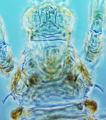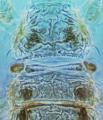Kurtomathrips morrilli
Recognition data
Distinguishing features
Female minute, usually wingless, with all major setae flattened and curved except at abdominal apex. Body and legs mainly yellow, with pair of dark spots laterally on each segment; eyes with four pigmented ommatidia. Head with eyes bulbous, much wider than cheeks. Antennae 8-segmented; segment III smaller than II and with no sensorium, IV with sensorium simple. Pronotum trapezoidal, surface coarsely sculptured, posterior margin with row of tubercles; major setae translucent and curved. Meso and metanotum transverse. Abdominal tergites I–VIII posterior margins with craspedum of rounded lobes; tergites each with two pairs of major, curved discal setae. Sternites II–VII with about 10 small discal setae.
Male similar to female; sternites III–VII with transverse pore plate.
Related and similar species
Four species are currently placed in the genus Kurtomathrips, two from south western USA, one from Mexico and one from Argentina, although the Mexican species is possibly a synonym. These minute, usually wingless, thrips all seem to be associated with the plant genus Parthenium.
Taxonomic data
Current valid name
Kurtomathrips morrilli Moulton
Original name and synonyms
- Kurtomathrips morrilli Moulton, 1927: 188
Family placement
Thripidae, Thripinae
Biological data
Life history
Breeding on leaves.
Host plants
Parthenium hysterophorus (Asteraceae)
Tospoviruses vectored
None
Crop damage
Reported as damaging cotton and also chrysanthemum (Bailey, 1957).
Distribution data
Area of origin
Western USA
Distribution
California, Arizona, New Mexico, Nevada, Texas, Florida, Hawaii, Jamaica, India.






